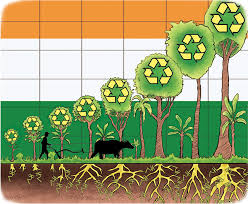Agriculture Notes – On Agroforestry – For W.B.C.S. Examination.
কৃষিবিদ্যা নোট – কৃষিবনবিদ্যা – WBCS পরীক্ষা।
AFTA defines agroforestry as an intensive land management system that optimizes the benefits from the biological interactions created when trees and/or shrubs are deliberately combined with crops and/or livestock. There are five basic types of agroforestry practices today in the North America: windbreaks, alley cropping, silvopasture, riparian buffers and forest farming. Within each agroforestry practice, there is a continuum of options available to landowners depending on their own goals (e.g., whether to maximize the production of interplanted crops, animal forage, or trees).Continue Reading Agriculture Notes – On Agroforestry – For W.B.C.S. Examination.
Benefits of Agroforestry
The benefits created by agroforestry practices are both economic and environmental. Agroforestry can increase farm profitability in several ways:
- the total output per unit area of tree/ crop/livestock combinations is greater than any single component alone
- crops and livestock protected from the damaging effects of wind are more productive
- new products add to the financial diversity and flexibility of the farming enterprise.
Agroforestry helps to conserve and protect natural resources by, for example, mitigating non-point source pollution, controlling soil erosion, and creating wildlife habitat. The benefits of agroforestry add up to a substantial improvement of the economic and resource sustainability of agriculture.
Key Traits of Agroforestry Practices
Agroforestry practices are intentional combinations of trees with crops and/or livestock which involve intensive management of the interactions between the components as an integrated agroecosystem. These four key characteristics – intentional, intensive, interactive and integrated – are the essence of agroforestry and are what distinguish it from other farming or forestry practices. To be called agroforestry, a land use practice must satisfy all of the following four criteria:
Intentional: Combinations of trees, crops and/or animals are intentionally designed and managed as a whole unit, rather than as individual elements which may occur in close proximity but are controlled separately.
Intensive: Agroforestry practices are intensively managed to maintain their productive and protective functions, and often involve annual operations such as cultivation, fertilization and irrigation.
Interactive: Agroforestry management seeks to actively manipulate the biological and physical interactions between the tree, crop and animal components. The goal is to enhance the production of more than one harvestable component at a time, while also providing conservation benefits such as non-point source water pollution control or wildlife habitat.
Integrated: The tree, crop and/or animal components are structurally and functionally combined into a single, integrated management unit. Integration may be horizontal or vertical, and above- or below-ground. Such integration utilizes more of the productive capacity of the land and helps to balance economic production with resource conservation.
Research and Development
To advance agroforestry in the North America, research is needed both on basic, process-level questions and on applied management techniques that are appropriate for commercial farm or forest operations. While basic research may, for example, investigate the long-term biological interactions between the components of an agroforestry practice, applied research should seek to maximize the tangible short and intermediate term benefits. Agroforestry practices should be tailored to readily integrate into existing farming or forestry enterprises, minimize the displacement of existing crops, use equipment and technical skills that are readily available, and allow some harvesting of products within conservation agroforestry practices (e.g., hardwood timber from riparian buffer strips). There is the potential to expand the participation of state, community and junior colleges, through their agriculture and forestry programs, in agroforestry research.
The greatest research need is to develop farm-level analyses of the potential economic costs, benefits, and risks associated with agroforestry practices. This information is a vital prerequisite to the objective comparison of both production-and conservation-driven agroforestry practices with alternative land use options. Furthermore, attention should be given to evaluations of future price trends in regional, national and international markets for commodities that can be produced using agroforestry (e.g., hardwood lumber or high-value, wind-sensitive crops). Research on tree-crop-animal-environment interactions should be pursued to provide a scientific basis for optimizing agroforestry designs.
Our own publications are available at our webstore (click here).
For Guidance of WBCS (Exe.) Etc. Preliminary , Main Exam and Interview, Study Mat, Mock Test, Guided by WBCS Gr A Officers , Online and Classroom, Call 9674493673, or mail us at – mailus@wbcsmadeeasy.in
Visit our you tube channel WBCSMadeEasy™ You tube Channel
Please subscribe here to get all future updates on this post/page/category/website



 Toll Free 1800 572 9282
Toll Free 1800 572 9282  mailus@wbcsmadeeasy.in
mailus@wbcsmadeeasy.in


















































































































